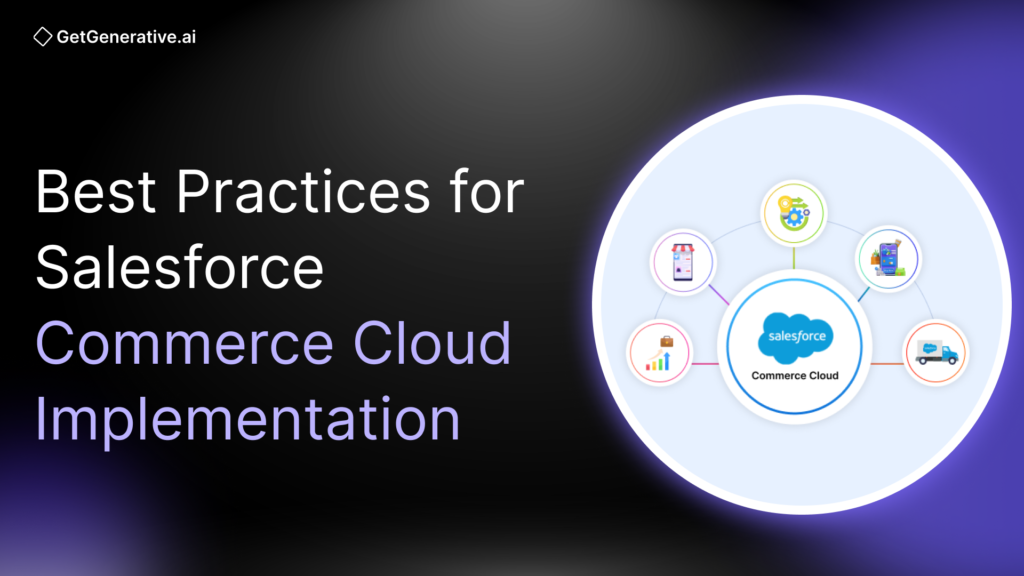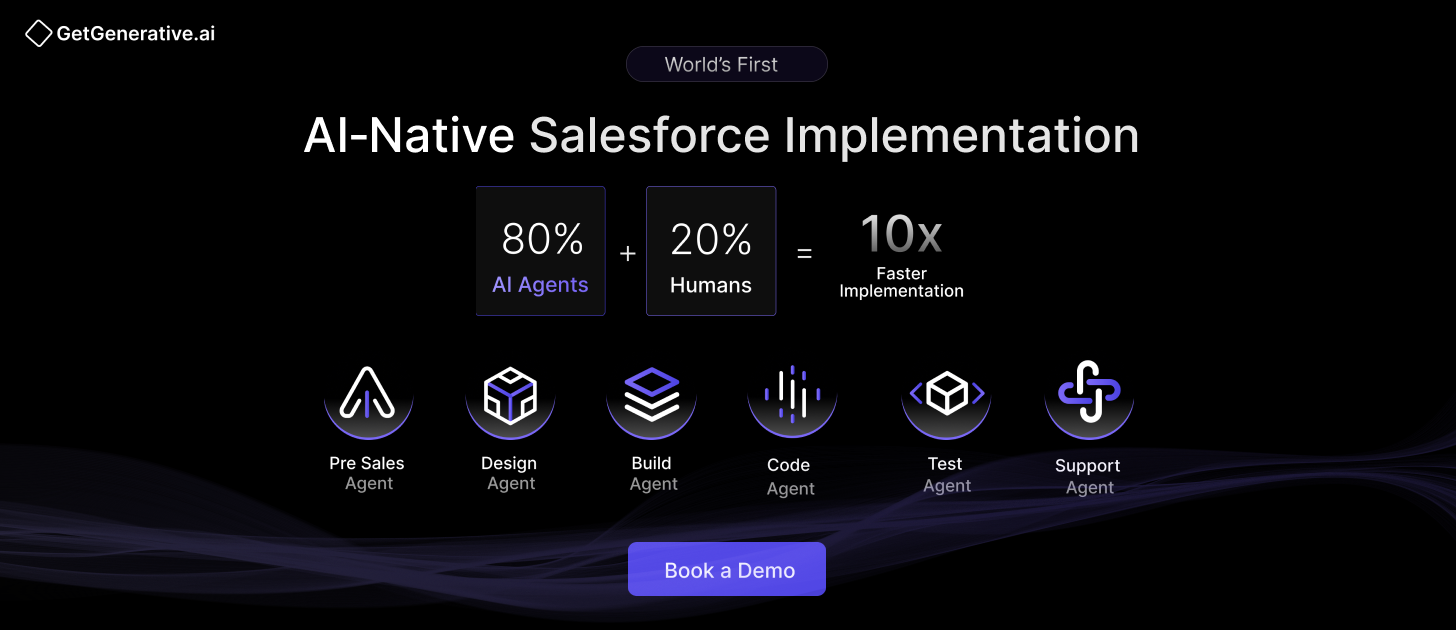Best Practices for Salesforce Commerce Cloud Implementation
With digital commerce projected to generate 55% of B2C revenue by 2026 (up from 32% in 2022, according to Salesforce), businesses cannot afford missteps in implementation.
This guide outlines best practices for successfully planning, executing, and optimizing a Salesforce Commerce Cloud rollout. Whether you’re building from scratch or migrating from legacy platforms, these evidence-backed insights are designed for senior digital commerce leaders and implementation stakeholders.
Align Business and Technology Goals Early
A successful Commerce Cloud implementation begins with clear business alignment. Before a single line of code is written:
Define measurable business outcomes, such as revenue growth, channel expansion, and customer acquisition.
Set KPIs around performance (e.g., conversion rates, order volumes, average cart value).
Prioritize strategic objectives like entering new markets, launching direct-to-consumer (D2C) channels, or unifying physical and digital operations.
Adopt an MVP-first approach: Many leading brands begin with a minimum viable product—such as one brand, one country, or one channel—and expand incrementally. Launching during low-traffic seasons, rather than just before Black Friday or holiday peaks, avoids SEO disruptions and reduces operational risk.
Involve stakeholders early. Build a cross-functional steering committee that includes merchandising, marketing, operations, and IT. Use this group to:
Define scope, timeline, and rollout phases.
Manage change requests and feature prioritization.
Align on governance policies within Business Manager (e.g. approvals, workflows, roles).
Training is key: Educate teams on Commerce Cloud tools like Page Designer, promotions engine, and catalog management well before go-live to ensure adoption.
Choose the Right Architecture: Multi-Site vs Multi-Realm vs Headless
SFCC offers flexibility through different architectural options. Your setup will impact everything from deployment timelines to site governance.
1. Single-Realm (Multi-Site Architecture)
All brands or regions run under one SFCC org. Benefits:
Shared codebase and centralized promotions
Lower licensing and infrastructure costs
Unified development pipeline
Trade-offs: All changes affect all brands, so tight coordination is essential.
Ideal for: Companies with similar product lines, centralized teams, and standardized experiences.
2. Multi-Realm (Isolated Instances)
Each business unit or region operates in its own SFCC realm. Benefits:
Independent deployments, codebases, and catalogs
Customized roadmaps per brand or geography
Trade-offs: Higher maintenance cost, duplicate efforts across orgs.
Ideal for: Diversified brands with independent teams and localized business models.
3. Headless Commerce (API-Driven Architecture)
In this model, SFCC provides the backend (via OCAPI/SCAPI APIs), while the front-end is decoupled and built using modern frameworks like React or Vue via PWA Kit or Vue Storefront.
Advantages:
Native-app-like performance and cross-channel flexibility
Easier A/B testing and UX enhancements without backend changes
Challenges:
Higher development complexity
Requires strong architectural planning and front-end skills
Best Practice: Headless can be layered on single or multi-realm architectures. You can start with SFRA (Salesforce Reference Architecture) and transition to headless incrementally.
Also Read – Salesforce Commerce Cloud Implementation Guide
Development and Code Management Best Practices
The foundation of long-term success lies in disciplined development practices.
Modularize Using Cartridges
Commerce Cloud uses cartridges (modular code packages). Structure your project as:
int_<integration>for external APIs and servicesapp_<brand>for storefront logicbm_<brand>for Business Manager extensions
Keep logic modular and brand-specific where required to improve maintainability.
Maintain Version Control and Naming Standards
Use Git (or similar) for source control; never develop directly in WebDAV.
Implement code review workflows with pull requests and linting (e.g. ESLint for JavaScript).
Adhere to consistent naming conventions for templates, scripts, and controllers.
Base on SFRA
Salesforce’s Storefront Reference Architecture (SFRA) provides a modern MVC framework with:
Prebuilt controller logic
Responsive templates
Asset bundling (Webpack, CSS/JS minification)
Extend, but do not overwrite core SFRA functionality. Use custom cartridges for modifications and keep SFRA up-to-date with every platform release.
Set Up CI/CD Pipelines
Use Jenkins, GitHub Actions, or Bitbucket Pipelines to automate:
Code linting and unit tests
Sandbox deployment
Staging promotions and replication
Production release on approval
Optimize for Performance and Scalability
Even the best UX fails if your site is slow. Google research shows that a 500ms delay can reduce conversions by 20%. Use these Commerce Cloud features and web best practices:
Front-End Optimization
Place CSS at the top, JavaScript at the bottom of pages.
Lazy-load images and videos not visible on page load.
Inline critical CSS via Page Designer for faster rendering.
Reduce HTTP Requests
Bundle CSS/JS files to reduce calls
Use WebP or AVIF for image formats
Minimize third-party scripts
Use Salesforce Edge CDN
Leverage Salesforce’s ECDN for static assets and configure cache-control headers properly in Business Manager.
Use Code Profiler
Commerce Cloud offers Development Mode Profiling to analyze controller execution time, memory use, and slow transactions. Schedule Production Mode sampling weekly to catch live issues.
Optimize Server Queries
Query only required fields
Use pagination for product listings
Cache frequently requested data at the controller level
Related Read – Top Challenges in Salesforce Commerce Cloud Implementation
Integrate Salesforce Commerce Cloud Into Your Broader Stack
One of SFCC’s core strengths is its integration with the broader Salesforce ecosystem and external platforms, enabling seamless customer experiences.
Connect with Other Salesforce Clouds
Sales Cloud: Enable B2B and D2C sales features like contract pricing, account-based discounts, and quote management.
Service Cloud: Surface commerce data (orders, carts, returns) for agents to manage service cases and process returns.
Data Cloud & Customer 360: Build a unified customer profile with real-time behavioral, transactional, and demographic data.
According to Salesforce, brands that connect data across clouds experience 29% higher revenue per visitor and 34% faster issue resolution.
Orchestrate with MuleSoft or iPaaS
Automate real-time flows between ERP, PIM, WMS, and order management systems (OMS).
Use MuleSoft’s prebuilt connectors for SAP, Oracle, or NetSuite.
Implement monitoring, retries, and alerts to prevent silent failures.
Utilize SFCC APIs (OCAPI and SCAPI)
OCAPI: Use Shop and Data APIs for storefront operations like cart, checkout, and product search.
SCAPI: Use newer, more performant APIs designed for headless and mobile-first experiences.
Best practice: Build custom services for mobile apps or in-store kiosks by exposing product and cart data through secure API endpoints.
Analytics and A/B Testing
Embed Google Analytics 4, Salesforce Einstein Analytics, or Adobe Analytics to track user behavior and conversion events.
Use built-in A/B testing (via SiteGenesis or 3rd-party tools) to test layouts, promotions, and checkout changes.
Measure bounce rate, cart abandonment, and lifetime value—then use that data to inform personalization rules.
Build a Robust Data Governance and Personalization Strategy
Without clean, well-managed data, even the most advanced platform underperforms.
Master Your Product and Customer Data
Ensure consistent taxonomy in your catalogs, categories, and attributes (e.g., size, color, brand).
Cleanse and de-dupe customer records across channels. Use Salesforce Identity Resolution to avoid duplicate profiles.
Enforce API and Data Security Best Practices
Assign scoped API credentials per integration—don’t share access across systems.
Limit data exposure via roles and permissions.
Encrypt sensitive data at rest and in transit.
Monitor API usage for anomalies (e.g., spikes in requests or unauthorized endpoints).
Enable Personalization Engines
Use Einstein Product Recommendations to personalize listings based on behavior and affinities.
Segment audiences for pricing, content, and promotions using real-time engagement data.
Salesforce reports show that personalized commerce journeys lead to 26% higher conversion rates on average.
Prioritize Security, Compliance, and Uptime
In e-commerce, trust is everything. A single breach can result in massive reputational and financial loss.
Enforce Strong Access Controls
Multi-Factor Authentication (MFA) is mandatory for all Business Manager and integration users.
Use granular roles for merchandisers, developers, and marketers.
Remove access immediately for offboarded users.
Stay Compliant with Industry Standards
Salesforce Commerce Cloud is PCI DSS Level 1 compliant, but merchants must configure webhooks, custom jobs, and third-party integrations securely.
Use Content Security Policy (CSP) headers to block XSS and malicious scripts.
Regularly audit integration logs and access records.
Implement Continuous Security Testing
Schedule penetration tests, vulnerability scans, and code reviews with security plugins.
Use Salesforce Event Monitoring or external SIEM platforms to detect anomalous behavior (e.g., mass login attempts, high cart abandonment).
For fraud detection, integrate with providers like Kount, Riskified, or Salesforce’s own Einstein Fraud Prevention.
Also Read – Essential Features of Salesforce Commerce Cloud
Continuous Improvement, Monitoring, and Governance
Post-Go-Live Optimization
Monitor KPIs such as time to purchase, funnel drop-offs, and promotion performance.
Use Einstein Analytics, Google Looker, or Tableau to create real-time dashboards.
Run experiments (e.g., alternate PDP layouts, checkout flows) to improve UX and conversion.
Upgrade and Maintain
SFCC releases new features regularly—test updates in sandbox environments before applying to production.
Automate regression testing using Selenium or TestCafe in your CI pipeline.
Keep custom cartridges compatible with the latest SFRA versions.
Scale Responsively
Prepare for peak loads (e.g., BFCM, Diwali, Christmas) with load testing.
Use Salesforce’s built-in auto-scaling infrastructure but also test integration layers (e.g., OMS, payment gateways) for bottlenecks.
Configure failover procedures and escalation protocols for downtime.
Final Thoughts
When implemented effectively, Salesforce Commerce Cloud becomes much more than a storefront—it becomes a strategic growth platform. The top-performing organizations treat it as a living product, one that evolves with customer expectations, new channels, and emerging technologies.
At GetGenerative.ai, we’ve completely redefined how Salesforce implementations are done, starting with AI at the foundation. This isn’t a traditional approach with AI layered on top. It’s a faster, more intelligent, AI-native model driven by our proprietary platform.
👉 Discover our AI-powered Salesforce consulting solutions




